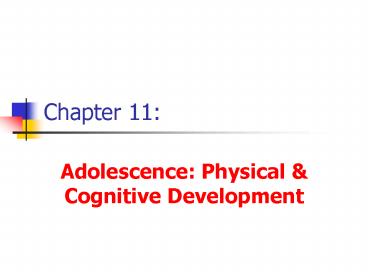Adolescence: Physical - PowerPoint PPT Presentation
Title:
Adolescence: Physical
Description:
Chapter 11: Adolescence: Physical & Cognitive Development Adolescence: Except for infancy, more changes occur during adolescence than at any other time of life ... – PowerPoint PPT presentation
Number of Views:134
Avg rating:3.0/5.0
Title: Adolescence: Physical
1
Chapter 11
- Adolescence Physical Cognitive Development
2
Adolescence
- Except for infancy, more changes occur during
adolescence than at any other time of life - Contemporary theorists see adolescence as a time
when biological, cognitive, social/emotional
functioning are reorganized. (and adolescents
have to adapt to these changes!)
3
What is Puberty?
- A stage of development characterized by reaching
sexual maturity and the ability to reproduce - Physical changes which mark the transition from
childhood to young adulthood - The onset of adolescent coincides with the advent
of puberty - Meaning, when puberty starts, no matter how
young, you are now an adolescent
4
Know
- Puberty occurs 2-3 years earlier in girls
compared to boys
5
Primary Secondary Sex Characteristics
- Their development is triggered by sex hormones
- 1. Primary sex characteristics (make
reproduction possible) ovaries, vagina, uterus,
fallopian tubes in women and penis, testes,
prostate gland, and seminal vesicles in men. - 2. Secondary sex characteristics (indicate
sexual maturation but are not involved in
reproduction) Breast development, deepening
voice, body odor, and the appearance of facial,
pubic and underarm hair.
6
What Happens During the Adolescent Growth Spurt?
- The stable growth patterns of middle childhood
end abruptly during adolescence - First height increases for approximately 2 years,
then declines - A spurt in weight happens 1 ½ years after height,
also for approximately 2 years then declines
7
Adolescent Growth Spurt, cont.
- Height
- Boys 14 ½ inches
- Girls 13 inches
- Adolescents tend to look thin because of the lag
in weight gain compared to height - Adolescents eat an enormous amount of food to
fuel this growth
8
Why do Adolescents Often Look Awkward and Gawky?
- Because different parts of the body grow at
different rates, called Asynchronous Growth - ? Hands and feet develop before the arms and the
legs - ? Legs grow before the shoulders and chest.
9
Why Do Adolescents seem to be Getting Taller
Maturing Earlier?
- Because they are!
- This is called the Secular Trend, and is present
in nearly all European countries and in the
United States. - What two factors appear to play a role in this
trend? - A. Better nutrition
- B. Healthcare
10
Pubertal Changes in Boys
- About 11-12 Growth of testes (which speeds the
development of testosterone) - 1 year later Growth of penis
- Soon thereafter Pubic hair
- By 15 Underarm/Facial hair
- 14-15 Voice deepens
- Testosterone also causes Acne
11
Pubertal Changes in Boys, cont.
- By 13-14 Frequent, and often unwanted erections
- 14-15 First Noctural Emission (also called
Spermarche) which shows the beginning production
of semen - 20-21 Adolescent growth comes to a close
12
Pubertal Changes in Girls
- 9-10 Estrogen stimulates the growth of breast
tissue (called breast buds) and they reach full
size within 3 years - Estrogen triggers growth of fatty tissue in the
hips/buttocks, and hips widen - Beginning at 11 Underarm and pubic hair
Breast buds developing
13
Pubertal Changes in Girls, cont.
- Estrogen causes growth of the labia, vagina and
uterus - Androgens cause the development of the clitoris
- Menarche (first menstruation) usually occurs
between 11-14, or 2 years - Menarche occurs much earlier in girls for the
past 150 years
14
What Accounts for the Earlier Age of Menarche?
- Girls must reach a certain body weight to trigger
pubertal changes such as menarche, called
Critical Fat Hypothesis - Menarche comes later to girls who have a low
percentage of body fat (those with eating
disorders/athletes) - Average body weight which triggers menarche
depends on the girls height
15
Question
- Do girls ovulate when they start their first
period? - No. They ovulate 12-18 mo after menarche
16
Body Image
- Adolescents are concerned about their physical
appearance - More satisfied toward the end of adolescence
- Females Body weight/slimness
- Males Gain weight/build muscles
17
What are the Cognitive Changes During Adolescence?
- They have reached Piagets formal operational
stage - Remember, this is his highest stage (age 11-12
and beyond) - Adolescents have reached cognitive maturity
according to Piaget
18
During the Formal Operational Stage the
Adolescent Can
- Classify objects or ideas
- Engage in logical thought
- Hypothesize in their investigations (like
scientists) - Group and classify symbols, statements, and even
theories - Follow and formulate arguments from their
premises, to their conclusions, and back (even if
they do not believe in them)
19
Know!
- Formal operational thinking is flexible and
reversible
20
Formal Operational Thinking is Characterized by 3
Cognitive Processes
- ?Hypothetical Thinking
- ? Sophisticated use of Symbols
- ? Deductive Reasoning
21
1. Hypothetical Reasoning
- Adolescents develop concept of what might be
rather than what is - Adolescents try on different clothing as well as
different attitudes - Realize that situations can have different
outcomes
22
2. Sophisticated Use of Symbols
- Understand X-the unknown (as used in algebra and
geometry) - Can perform mental operations with symbols (ex.
PEMDAS, and math/physics/ algebra, and skills for
engineering, architecture) - Can understand, appreciate, and sometimes produce
metaphors
23
3. Deductive Reasoning
- Judge right and wrong in specific situations by
reasoning deductively from moral principals - Decentration allows the adolescent to focus on
many aspects of a situation at once to arrive at
a moral judgment or to solve a moral dilemma
24
Question
- What are some of the gender differences in
cognitive abilities?


















![[PDF] Pediatric Dentistry: Infancy through Adolescence (PEDIATRIC DENISTRY) 5th Edition Ipad PowerPoint PPT Presentation](https://s3.amazonaws.com/images.powershow.com/10085917.th0.jpg?_=20240726126)












